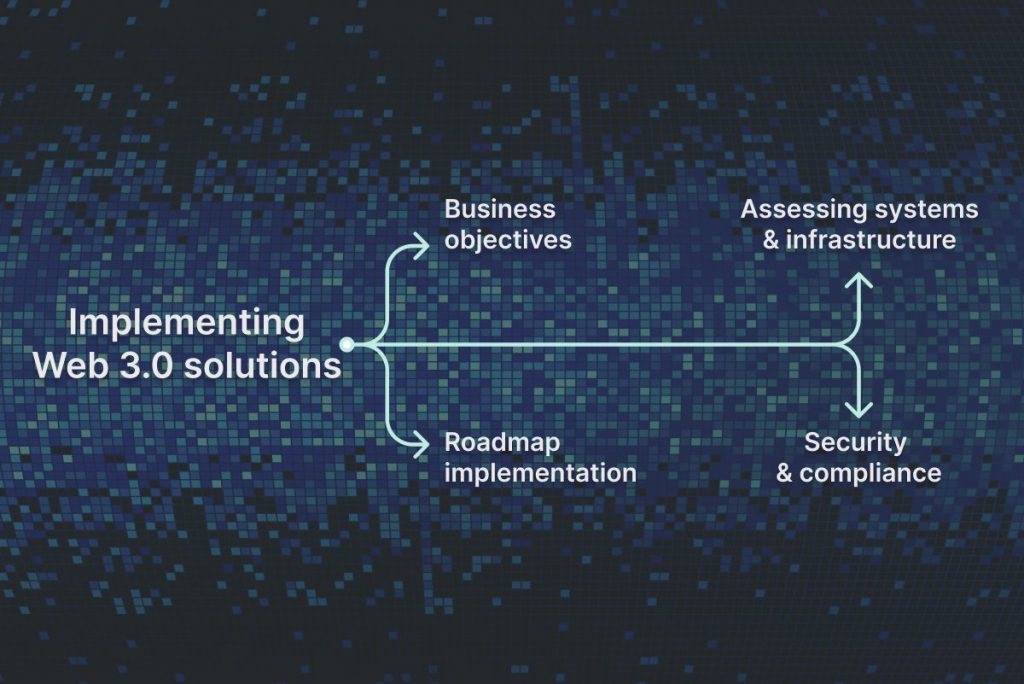I. Introduction
Web 3.0 is the next generation of the internet that aims to transform the way businesses operate online. It is an evolving paradigm shift that is driven by decentralized systems, blockchain technology, and artificial intelligence. In Web 3.0, businesses can access a more secure and transparent online environment that enables them to engage with their customers in more meaningful ways, streamline their operations, and increase profitability.
The adoption of Web 3.0 technologies is crucial for businesses looking to remain competitive in today’s digital landscape. It enables businesses to tap into new and emerging technologies that can drive innovation and growth. However, businesses face a number of challenges in adopting Web 3.0 technologies, including a lack of knowledge and expertise, security concerns, and the need to restructure existing systems and processes to accommodate the new paradigm shift.
Despite the challenges, the potential benefits of Web 3.0 solutions for businesses are significant. With Web 3.0 solutions , businesses can achieve greater efficiency, security, and transparency in their operations. They can also leverage emerging technologies such as blockchain and artificial intelligence to create new revenue streams, improve customer engagement, and gain a competitive edge in their industry.
II. Understanding Web 3.0 Solutions for Businesses
Web 3.0 solutions for businesses are an emerging trend that seeks to leverage blockchain technology and other decentralized technologies to create more secure and transparent business systems. One of the main components of Web 3.0 is blockchain technology, which is essentially a decentralized database that is maintained by a network of computers.
Blockchain technology provides several benefits for businesses, such as increased security, transparency, and efficiency. By using blockchain technology, businesses can reduce the risk of fraud and hacking, and they can also increase the speed and accuracy of their transactions.
Another important aspect of Web 3.0 solutions for businesses is decentralized applications, or DApps. DApps are essentially applications that run on a decentralized network of computers, rather than on a centralized server. This makes DApps more secure and resistant to censorship and hacking. DApps can be used in a variety of ways, such as for secure messaging, file sharing, and social networking. They also have the potential to disrupt industries such as finance and real estate by providing more efficient and transparent systems for transactions.
Smart contracts are another key component of Web 3.0 solutions for businesses. Smart contracts are essentially self-executing contracts that are stored on a blockchain. They allow for secure and transparent transactions without the need for intermediaries such as banks or lawyers. Smart contracts can be used for a variety of purposes, such as for supply chain management, insurance, and real estate transactions. They have the potential to revolutionize the way businesses operate by reducing the need for intermediaries and increasing the speed and efficiency of transactions.

III. Benefits
Web 3.0 solutions offer businesses several benefits that can help them stay ahead of the competition. One of the main advantages of Web 3.0 is improved transparency and accountability. With the use of blockchain technology and decentralized applications, businesses can create a more transparent and trustworthy environment for their customers. Transactions can be tracked in real-time, and the authenticity of data can be verified, helping to build trust with customers and other stakeholders.
Another benefit of Web 3.0 solutions is enhanced security and privacy. Traditional centralized systems are often vulnerable to cyberattacks and data breaches, but Web 3.0 solutions, such as blockchain technology, provide a more secure environment for businesses to store and exchange data. Blockchain technology uses cryptography and a distributed ledger to ensure that data is immutable and cannot be altered without the consensus of the network, providing a high level of security for businesses.
Web 3.0 solutions can also lead to cost savings and efficiency gains for businesses. By automating processes and removing intermediaries, businesses can reduce transaction costs and improve the speed and accuracy of their operations. Additionally, new business models and revenue streams can be created through the use of Web 3.0 solutions, such as tokenization, which allows businesses to create new types of assets that can be traded on decentralized platforms. Overall, Web 3.0 solutions offer businesses a range of benefits that can help them stay competitive in a rapidly changing digital landscape.

IV. Key Considerations
When considering implementing Web 3.0 solutions, businesses need to take several key considerations into account. Firstly, it’s important to define business objectives and goals that can be achieved through the adoption of Web 3.0 solutions. This could include improving transparency, enhancing security and privacy, or creating new revenue streams. Once business objectives have been defined, it’s important to assess the current systems and infrastructure in place to identify potential areas for improvement and transformation. This will help to ensure that the solutions being implemented will be effective and fit for purpose.
Another key consideration when implementing Web 3.0 solutions is to build a roadmap for implementation. This should involve identifying the different stages of implementation, the timeline for each stage, and the resources required to achieve each stage. It’s also important to ensure that IT and business strategies are aligned to ensure that the solutions being implemented are in line with the overall objectives of the business.
Finally, it’s important to ensure that security and compliance are taken into account when implementing Web 3.0 solutions. This could involve ensuring that appropriate security measures are in place to protect sensitive data, or that compliance requirements such as GDPR are met. It’s also important to ensure that employees are bought in to the implementation of Web 3.0 solutions, and that they receive the necessary training and support to use the solutions effectively.

V. Trends and Future
Web 3.0 solutions are rapidly evolving, and businesses need to stay informed about emerging technologies and future trends. One of the most exciting trends is the convergence of Web 3.0 with the Internet of Things (IoT). This combination has the potential to create an entirely new ecosystem of decentralized applications that can interact with the physical world. For businesses, this could mean more efficient supply chains, better inventory management, and new revenue streams.
Another trend to watch is the rise of decentralized finance (DeFi) on the blockchain. DeFi is a rapidly growing ecosystem of financial applications that operate on a decentralized network. It has the potential to revolutionize the financial industry by offering faster, cheaper, and more transparent financial services. Businesses can benefit from DeFi by streamlining payment processing, reducing fees, and gaining access to new sources of capital.
Looking further into the future, Web 3.0 has the potential to create entirely new business models that are currently unimaginable. With the ability to tokenize any asset or service, businesses can create new revenue streams and engage customers in new ways. As more people come online and adopt Web 3.0 technologies, businesses will have new opportunities to reach a global audience and connect with customers in ways that were previously impossible.

VI. Conclusion
In conclusion, Web 3.0 solutions offer numerous benefits for businesses, including enhanced security and privacy, improved transparency and accountability, cost savings, and new business models and revenue streams. However, implementing these solutions requires careful planning and consideration, including defining business objectives and goals, assessing current systems and infrastructure, and ensuring security and compliance.
As emerging technologies continue to advance, the future of Web 3.0 solutions for businesses looks promising. With the potential to drive innovation and growth, it is essential for businesses to stay informed and up-to-date with the latest trends and developments in this field.If you’re a business looking to implement Web 3.0 solutions, it’s crucial to work with an experienced and knowledgeable partner.
At Lasting Dynamics, we have the expertise and resources to help you successfully navigate the challenges and opportunities of Web 3.0. Contact us today to book a free call and learn more about how we can help you achieve your business objectives with Web 3.0 solutions.
